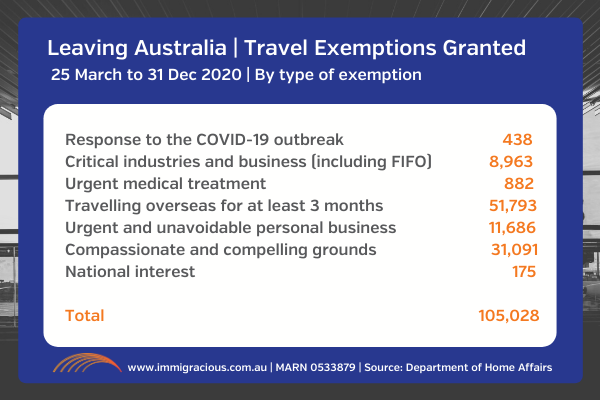Leaving Australia in the COVID-19 Era | Outbound Travel Exemptions
With reportedly more than 11,000 Australians getting Outbound Travel Exemptions to head overseas each month, there are many reasons why a person may need to leave Australia – for example, for Compassionate circumstances or Critical Work overseas.
According to FOI data from the Department of Home Affairs, 105,028 Travel Exemptions were approved for people to leave Australia between 25 March and 31 December 2020 – here’s a breakdown:
Most Outbound Travel Exemptions were granted for overseas stays of at least three months (51,793 exemptions) followed by compassionate and compelling grounds (31,091 exemptions). Compassionate cases included the death or serious illness of a close family member and parents travelling for surrogacy, adoption or picking up a child from overseas;
Urgent and unavoidable personal business was the third largest category with 11,686 exemptions granted;
Critical industries and business travel secured 8963 exemptions;
The smallest categories were Urgent medical treatment not available in Australia (882 exemptions), Response to the COVID-19 outbreak (438 exemptions) and National interest (175 exemptions).

Here’s what you should know about Outbound Travel Exemptions and how the Government is prioritising cases to leave Australia.
Do I need a Travel Exemption to leave Australia?
Australian Citizens or Permanent Residents must not travel outside Australia unless they meet an Outbound Travel Exemption to leave Australia.
There are two types of Outbound Travel Exemptions – Automatic and Application-based exemptions.
You may be automatically exempt from travel restrictions and may be able to leave Australia without applying for an exemption if you are:
An airline, maritime crew or associated safety worker
A New Zealand citizen holding a Special Category (subclass 444) visa, even if you are usually resident in Australia
Engaged in the day-to-day conduct of inbound and outbound freight
Travelling in association with essential work at an offshore facility in Australian waters
Travelling on official government business (including members of the Australian Defence Force and any Australian Government official travelling on a diplomatic or official passport)
Travelling directly to New Zealand and you have been in Australia for 14 days or more immediately before your travel date (Australia-New Zealand restrictions are subject to change in response to COVID-19 outbreaks)
Note: In August 2021, Health Minister, Greg Hunt removed an automatic travel exemption that allowed Australians normally living overseas to return to their usual country of residence without having to apply for permission to leave Australia.
Updated: 19 August 2021.
You must apply for an Outbound Travel Exemption if your travel is:
Part of the response to the COVID-19 outbreak, including aid provision
For a business/employer
To receive urgent medical treatment not available in Australia
To leave Australia for a compelling reason for three months or longer (a statutory declaration must be provided)
Based on compassionate or compelling grounds
In the national interest
Your are ordinarily resident in a country other than Australia – see our article here.
Substantial supporting evidence is required. You may wish to seek professional advice if you are unsure if you meet the requirements.
Other things to note:
People that hold an Asia-Pacific Economic Cooperation (APEC) Business Travel Card (ABTC) must also apply for a Travel Exemption to leave Australia.
To apply for an Outbound Travel Exemption to leave Australia for three months or longer, the travel must be for a compelling reason and evidence must be provided to support your claims.
Australian citizens and Permanent Residents under 50 years of age with an approved Outbound Travel Exemption can now access COVID-19 vaccinations – the Government prefers that Australians are vaccinated prior to travelling overseas. Eligibility conditions apply.
Updated: 19 August 2021.
Do Temporary Visa Holders need a Travel Exemption to leave Australia?
Temporary Visa Holders do not need an exemption to leave Australia, however they will generally not be permitted to return to Australia without an Inbound Travel Exemption.
If you intend to leave and return to Australia, you may wish to seek professional advice.
How are Outbound Travel Exemptions prioritised?
As per the Department of Home Affairs’ process guidelines, case officers assess early on whether there is enough supporting evidence and if any ‘automatic exemption criteria’ have been met.
Step 1 – ‘Assessment Officers’ make an initial assessment and determine that an Outbound Travel Exemption application is either:
Not referred to a decision maker – Due to insufficient evidence
Assessed as exempt – Assessment Officers can only decide on cases that meet the automatic exemption criteria or request more than three months of travel.
No longer required – Due to duplicate requests in the system or requests for withdrawal
Referred for discretion – For cases that need to be referred to a ‘Decision Maker’. Applications are ‘queued for consideration’ by a Decision Maker if they have sufficient evidence for the below criteria:
Compassionate and compelling
National interest / Australian Government invitation
Critical medical services
Critical skills
Refugee and humanitarian (class XB) Visa Holders
Urgent medical treatment / evacuation
Step 2 – ‘Decision Makers’ review cases categorised as ‘referred for discretion’.
These process guidelines indicate that:
Applications with insufficient supporting evidence may be rejected very quickly – although the Department stated these decisions occur in limited circumstances and only with a Team Leader’s approval
Applications for more than 3 months of travel, as well as cases that meet the ‘automatic exemption criteria’ may be prioritised
Making duplicate requests can delay an assessment
In our experience, applications are also prioritised based on the intended travel date to leave Australia.
How long does it take to get a Travel Exemption?
According to the Department of Home Affairs, most Travel Exemption requests to depart Australia are finalised within 48 hours, but some complex requests may take longer.
Outbound Travel Exemptions can be approved quickly if it is very clear to the Department that the evidence meets the exemption criteria.
As applications are decided on a case-by-case basis, you should apply for an exemption at least two weeks, but not more than two months before your planned travel.
What happens once a Travel Exemption is refused or granted?
If you are not granted a Travel Exemption, you should not continue with your travel plans as you will not be able to leave Australia.
Unfortunately, there is no guarantee that your Travel Exemption will be approved, however the good news is there is no cost to applying for a Travel Exemption and you can reapply. You may, however, wish to seek professional advice before reapplying.
The exemption is recorded in the Department’s electronic systems and if approved, you must take evidence of the exemption decision to the airport.
You can then proceed to leave Australia.
Immigracious Perth Migration Agents
We hope these updates are helpful. You may also be interested in our other Australian immigration insights:
Critical Work and Compassionate Travel Exemptions to come to Australia
Partner Visas in the COVID-19 Era – What you should know
Australia Travel Declarations | What to Do Before Travelling
If you have any queries about applying for a Travel Exemption to leave Australia or your visa options, we encourage you to get in touch with Immigracious’ Registered Migration Agents. Simply contact hello@immigracious.com.au
Source:
The Department of Home Affairs
Immigracious’ Registered Migration Agents







Comments